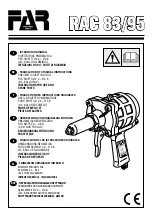
IMPORTANT SAFETY INSTRUCTIONS FOR FUEL
CELL
DANGER
■
Fuel cell, fuel and propellant are flammable
under pressure.
Explosion / Fire Hazard
M us t t o f ol l ow al l instructions
otherwise may result in fire and
explosion when handling dispensers
for combustible gas for the purpose
of storage, transportation, inserting into and
taking out of the tool and disposal.
■
Do not smoke when handling the fuel cell.
WARNING
Do not inhale its contents.
In case of being inhaled ; the person
affected should be taken into the
open air and brought into a comfortable
position.
Expanding gases cause low temperatures.
Fluid gases might cause injuries when getting
in touch with skin or eyes.
In case of contact with skin ; wash the contact
surface carefully with warm water and soap and
apply a skin cream when dry.
In case of contact with eyes ; rinse the open eyes
under running water.
Contact a doctor if necessary.
Store in well-ventilated area.
Store within
41°F
(
5°C
)
~
77°F
(
25°C
)
(
e.g
.
Do not store under the direct sunlight or in a
vehicle).
Do not expose to an open flame and sparks.
Do not puncture or open the fuel cell.
Do not refill, reclaim or recycle the fuel cell.
Dispose of according to local regulations for
aerosol products.
Do not dispose of fuel cell with other scrap for
recycling.
Keep out of reach of children.
IMPORTANT SAFETY INSTRUCTIONS FOR
BATTERY CHARGER
WARNING
Death or serious bodily injury could result from
improper or unsafe use of battery chargers.
To avoid these risks, follow these basic safety
instructions:
READ ALL INSTRUCTIONS
1.
This manual contains is important safety and
operating instructions for battery charger Model
504.4.04.010.XX.
2.
Before using battery charger, read all instructions
and cautionary markings on (1)nailer,(2) battery
charger, (3) battery.
3.
To reduce risk of injury, only use
ORION
rechargeable
battery type504.4.04.011.08. Other
type of
batteries may burst causing personal
injury and
damage.
4.
Do not expose battery charger to rain or snow.
5.
Use of an attachment not recommended or sold
by the battery charger manufacturer may result
in a risk of fire, electric shock, or injury to persons.
6.
To reduce risk of damage to electric plug and
cord, pull by plug when disconnecting battery
charger.
7.
Make sure cord is located so that it will not be
stepped on, tripped over, or otherwise subjected
to damage or stress.
8.
An extension cord should not be used unless
absolutely necessary.
Use of improper extension cord could result in a
risk of fire and electric shock. If extension cord
must be used make sure:
a)
That blades of extension cord are the same
number, size, and shape as those of plug
on battery charger;
b)
That extension cord is properly wired and in
good electrical condition;
c
)
That wire size is large enough for AC
ampere
rating of battery charger as specified in table 1.
4







































